Returning Home
Mark kicks off Dominaria Preview Week with a look at how the vision design for the set came together.
Welcome to the first Dominaria Preview Week. Those are words I've been dying to say for a long time. Today, I'm going to start to tell you the story of Dominaria's vision design and show off a whole bunch of preview cards. Before I do that, I need to introduce you to the Dominaria Vision Design team.
Mark Rosewater (Lead)

I remember when, while plotting out the seven-year plan, we realized we'd be able to revisit Dominaria on the 25th anniversary of the game. We hadn't been back to Magic's original home plane for thirteen years, so I was excited to have the opportunity to return to Magic's old stomping ground. As you will see, it turned out to be a bit harder than anyone expected.
Aaron Forsythe

As senior director of Magic R&D, Aaron is my boss. He doesn't get the chance to work on a lot of sets, but Aaron said if he could only work on one set for the year, it was going to be Dominaria. Aaron, like me, is an old-timer who has a lot of fondness for the sets from Dominaria. I don't get to work a lot with Aaron on design teams, so it was great having him back.
Ethan Fleischer
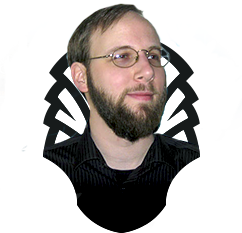
Ethan led the exploratory design team for Dominaria and, along with Kelly Digges, is one of the experts of Dominarian history. (I believe Ethan has read all the books that take place on Dominaria—which, by the way, is a lot of books.) Ethan was the heart of this design team, with a passion that infected everyone else on the team.
Ian Duke

Ian was the representative from the Play Design team. I think when we started he was actually the development representative, but I'll get to that soon enough. Ian's job was to make sure that all the crazy things we were coming up with actually worked in a tournament setting. He would cost the cards before playtests and was responsible for sanity-checking our ideas.
Kelly Digges

Kelly was the creative representative. Not only were there a lot of story pieces to coordinate, but Dominaria was going to be a set with a lot of references to the past, and Kelly (along with Ethan) was our sourcebook. There were a lot of balls to juggle, but Kelly kept them all in the air.
Gavin Verhey

Gavin was my strong second taking care of the file. That means he took notes at all the meetings, tracked every change, and then input the cards into the database, filling in any gaps. This was Gavin's first time in this role and he did a wonderful job.
Richard Garfield
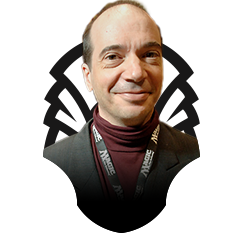
For years, when people ask if Richard would ever be on another design team, I always said all he had to do was ask. It then came to my attention that when Richard was asked if he'd ever be on another design team, he always replied he'd say yes if I ever asked. Well, years went by where the two of us were unaware we were each waiting on the other to say something. Once this was brought to my attention, I called up Richard and said, "How would you like to be on another Magic design team? I think I have the perfect set." As always, it was a treat to work with Richard on a design.
The Elephant in the Room
The reason it took so long to return to Dominaria was that the plane had a small problem. In modern Magic, our planes each have a clear and definitive identity. Innistrad is the gothic horror plane. Theros is the Greek mythology plane. Amonkhet is the Egyptian-inspired plane. Zendikar is the adventure-world plane. Ravnica is the city of guilds plane. Because we had spent so many years and so many sets on Dominaria, it didn't have a singular identity. Was it an ice plane? A jungle plane? A mutant plane? A post-apocalyptic plane? It was all of the above. The challenge before us was to capture the essence of Dominaria while carving out a clean identity moving forward. And that, it turned out, was very hard to do.
Ethan and Kelly compiled lists of everything that Dominaria had ever been creatively—the places, the people, the creatures, the artifacts, the magic, the stories, everything. We divided up the material into three piles: Definitely Keep, Maybe Keep, and Let's Not Dwell on This Part. When we were done, we realized we had a lot to cover. Could one theme hit it all?
Exploratory design spent some time looking back at Dominaria mechanically. We listed every mechanic that had ever appeared in an expansion set on Dominaria. We also looked back at things we once did mechanically that we had since stopped doing. It was at this point that I invoked what I called the "Time Spiral rule." Our job, I said, was not to return Magic to the past (aka make it play like it once did), but to take elements of Magic's past and bring them forward to modern gameplay. We had made this mistake during Time Spiral block and caused endless confusion about what was and what wasn't accepted in modern Magic. Dominaria could and should have nostalgia (as the good parts of Time Spiral did), but not by violating the color pie or returning to things we had purposefully removed from the game. Another lesson from Time Spiral was making sure that the cards were cool out of context. For example, if we had a powerful sword from the past, it needed to be exciting in a vacuum. You didn't need to know that that sword once belonged to a famous Magic character from the past to enjoy the card, but if you did, it would be added value.
While all this was going on, R&D decided it wanted to fundamentally change how we made Magic sets, and one month in, the yearlong design turned into a six-month vision design, the first of its kind. What exactly was a vision design and how did it work in the new R&D system? We were going to have to figure that out.
Looking Back
Vision design happens before the worldbuilding push for which we bring in outside artists to flesh out the world visually. Usually, to get a sense of what we're trying to do, the creative team will make a few images to help give us inspiration. For Dominaria, Mark Winters, art director for the set, had Sam Burley create a piece that showed the contrast of the world being reborn while incorporating elements of its past. Mark, and the rest of the creative team, felt strongly that Dominaria, after years of hard times, was reflourishing, but it was doing so while incorporating elements of its past. In the art, we saw a new city that was being built up around remnants of the Phyrexian invasion. Its past wasn't being ignored but rather was becoming part of its present. I really liked the idea that Dominaria was a world whose present was defined by its past.

And that's when it clicked for the design team. What if the defining trait of Dominaria was history? What if it was a world obsessed with its own past? It was a world where a lot happened, but all of it shaped Dominaria into what it had become, a vibrant world that always found a way to thrive even when encountering the harshest of adversity. The cool part of this was that the history wasn't new for the audience. Just as Dominaria had lived it, so too had we, the audience, lived it. The Brothers War. The Phyrexian Invasion. The Mending. These were all giant events on Dominaria, but they were all also big moments of the game. The history theme gave the world an identity and tied directly into the nostalgia theme that we also wanted in the set.
As we dug into this theme, we discovered that it was something already baked into the world. Even when the game started, Dominaria was a world with a past that defined its present. Urza and Mishra were artificers digging up Dominaria's past to learn about the Thran, an ancient civilization. The deeper we dug into the theme, the more we realized it was the perfect fit for Dominaria. The one question that remained centered on what that meant mechanically. How do you represent history through gameplay?
The Search Begins
Once I knew history was our theme, we had a meeting where we brainstormed what history meant mechanically. The one thing we kept coming back to was the graveyard. It was filled with creatures and objects that were once on the battlefield and spells that had been cast turns ago. Flashback got mentioned numerous times, as it's a mechanic literally named after looking back to the past. Just one small problem: both Shadows over Innistrad and Amonkhet (the latter of which was going to coexist with Dominaria in Standard) had strong graveyard themes. Also, our experiment of having the same theme overlapping several sets apart hadn't gone as well as we had hoped. The graveyard, as a major theme, was off limits, as was flashback due to Amonkhet using aftermath.
Okay, what represented history other than the graveyard? How about artifacts? Many of them represented objects of long ago. The name especially connoted a sense of age. How about legendary permanents? They themselves could be famous, or they could represent a lineage hinting at famous things from long ago. Maybe certain enchantments? Every once in a while, we used them to represent the telling of a story. And that was about it for our list.
We looked at each piece. An artifact theme didn't feel right for this word. Yes, there were a bunch of famous artifacts, but Dominaria didn't feel like a world specifically about artifacts. A legendary theme felt more at home in Dominaria, it definitely was the place of a lot of famous characters, but we'd tried legendary as a theme before in Champions of Kamigawa block and it proved problematic. Legendary permanents skew toward higher rarities and the as-fan (the percentage of cards as they show up in a booster pack) was too low to make it matter enough mechanically, especially in Limited. "Enchantments matter" as a general theme felt wrong in Dominaria, and the subset of enchantments we were talking about was tiny. No, none of it seemed to work.
That's when I made a suggestion. What if we came up with a word, like "historic," and used it as a supertype? Anything that represented something historic would just get labeled. We'd have historic creatures, historic artifacts, historic enchantments, and historic lands. We tried a playtest, but this plan had two problems. One, as we had learned with devoid, many players hate what R&D calls "markers." That is, words that have no mechanical meaning other than being something to refer to on other cards. Two, the mechanic was not at all backward compatible. It felt wrong to travel back to Dominaria and then make a mechanic that you couldn't mix with old cards from Dominaria.
It was at this point that Aaron made a suggestion. What if we just grouped artifacts and legendary things together? What if we represented history mechanically by combining two different things that represented history in the game? I was very fond of this idea because it tapped into something I'd been trying to do with the historic supertype. I love when you introduce a theme that makes players think differently during deck building. I was trying to find a way to group different categories of things together, but Aaron's idea did the same thing from a different direction. Players had made artifact-themed decks before. They'd made legendary-themed decks before. But the one thing they'd never done was make a deck that mixed those themes together. This was a way to make something new without creating a new category.
It also helped us solve the legendary as-fan problem from Champions of Kamigawa. Legendary permanents, in isolation, have an as-fan problem, but mixed with artifacts, which we could weave in at lower rarities, we had a workaround. (Dave Humpherys, the set's lead designer, added in a legendary-creature-per-pack component that also helped with the as-fan issue.)
How we got from Aaron's idea to the final version of historic is going to be a whole article unto itself (it had quite a journey), but for now, what's important is that it was the mechanic that helped us capture that "history matters" element of the set.
Something Old
For most sets, we try to bring back a mechanic. For Dominaria, I knew it was a requirement. And it couldn't just be any returning mechanic; it had to be one from Dominaria. Luckily, there were a lot of sets to pull from. During exploratory design, we made a list of every keyword mechanic that originated in an expansion set on Dominaria. We assumed we'd have a world of choices, knowing how many expansions we were talking about. However, it turned out we didn't. First, Dominaria as a setting occurred in the early years of Magic, back when we were stingier with keyword mechanics. For example, during the early blocks, we would only use two named keyword mechanics for the whole year. Then, we had the problem that some of the early mechanics just became part of the game. Also, our miss/hit ratio was just higher in the early days. When the dust settled, we discovered that we had three good choices:
- Cycling
- Flashback
- Kicker
These three were all solid, time-tested mechanics, all of which we had brought back at one time or another. Any would be an excellent addition to the set. Just one small problem—Amonkhet had essentially just used two of them. It had cycling, and aftermath was too close to flashback to reuse flashback so soon after. That left us with a list of one: kicker.
That's how kicker got in the set.
Luckily for us, kicker is a useful and flexible mechanic and the set wanted a mana sink, so all was good.
Something New
We had a "history" mechanic to act as glue. We had kicker as a returning mechanic to add a little nostalgia. What we were missing was some splash. As we were celebrating Magic's 25th birthday with Dominaria, I wanted to look forward as well as backward. I wanted the set to have something brand new to remind everyone on the big anniversary that Magic, even after 25 years, hadn't lost the ability to surprise its audience with something new.
The thing that had come up numerous times when talking about Dominaria was that it was a world with history, a world with stories. Was there some way to bring those stories to life mechanically? I thought there was—interestingly based on an idea from Magic's past.
When we were first making the planeswalkers, we had a version where they had abilities that went off in sequence, one per turn. The one I remember was the earliest Garruk.
Early Garruk
Resilience – 5
1) Make a 2/2 green Wolf creature token.
2) Double the number of Wolf tokens you control.
3) All Wolf creatures you control get +2/+2 and gain trample until end of turn.
The way the early planeswalkers worked was, when they entered the battlefield, their first effect went off. In Garruk's case, he'd make a 2/2 Wolf. Then at the beginning of each turn, the planeswalker would advance to the next ability. On turn two, Garruk would double his Wolves, going from one to two. Then on the next turn, he would grant +2/+2 and trample to all his Wolves, which would most likely attack. On his following turn, he'd go back to his first ability and make a Wolf. This sequence would continue as long as he was on the battlefield. Note that the original planeswalkers were attackable just like current planeswalkers (based on an idea Richard had designed in original Ravnica for a card type called Structures that never got used).
The problem with this system was that it often resulted in silly things. For example, you play Garruk and get a Wolf token. Your opponent destroys it. Turn two, Garruk doubles your Wolf tokens, but you don't have any, so he doesn't do anything. Then, turn three, he grants all your Wolves +2/+2 and trample, but you don't have any, so he doesn't do anything. The comments I kept getting back was the planeswalkers felt silly and had no sense of agency. Obviously, we changed them to the current system where you could choose what they did. The loyalty structure allowed us to give them something to work up to over time.
When we were brainstorming how to capture the essence of a story, I was reminded of the proto-planeswalkers. Stories took place in a particular order and there was no need for them to have a sense of agency. Could we use this structure as a jumping-off point?
Richard was fascinated by this idea and went home and made a series of different playtest cards, exploring what we could do with this mechanic.

Richard came up with the idea that we could have modes that did the same thing and use icons to represent what the modes did. We also latched onto the idea of using actual Dominarian stories as the inspiration for the designs. This was another mechanic that went through a lot of iteration in set design, but the core idea of a story that acted itself out over multiple turns of gameplay stuck the whole way through.
We talked about having them be a new card type, but decided it was better to just make use of enchantments. Originally, they were legendary to be part of the historic mechanic, but we later decided they worked better without being restricted to having one on the battlefield at a time and changed historic to care about artifacts, legendary things, and Sagas. We also made the decision to have them go away when they were done, as we felt stories had a beginning, middle, and end and then were over. There will be more on the evolution of Sagas in columns to come.
Weathering the Storm
And that is the bare bones of the vision design. Dominaria's theme was history, and we had three mechanics (historic, kicker, and Sagas) to convey it. We also spent significant time touching upon lots of individual card-by-card ideas of things to revisit. (I'll cover a bunch of these in my card-by-card design columns.)
Speaking of revisiting, it's time for me to get to my previews, and I want to start by showing you a card a long time in coming. The card in question is Jhoira, Weatherlight Captain. For those who know your Magic history, she goes way back. In fact, she was the first captain of the Weatherlight, a role she reacquires in the Dominaria story.
Jhoira is a tinkerer (she, in fact, is the person who appears on the original art for Tinker in Urza's Saga). She never got a card back in the day, so we decided to right that wrong in Time Spiral. Somehow, though, we ended up giving her a suspend-related ability that never really matched who she was. Add to that the fact that we somehow have never managed to make a blue-red legendary creature with an artifacts-matter theme, and it was clear that Jhoira was destined to get a new card. Once we had the historic mechanic, we knew it was a perfect match for Jhoira, one of the most history-focused characters in the game. Finally, a Jhoira that's a Jhoira and a blue-red "artifacts matter" commander.
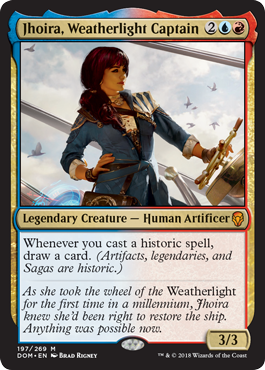
What's a captain without a crew?
Click here to see the all-new Weatherlight crew!
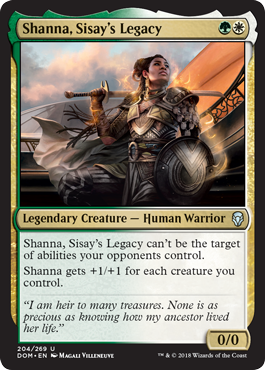
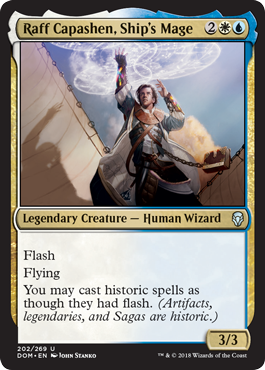
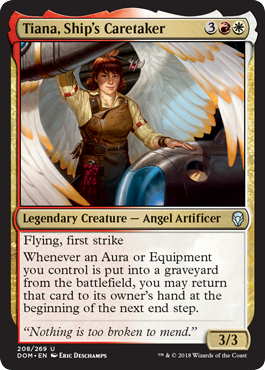

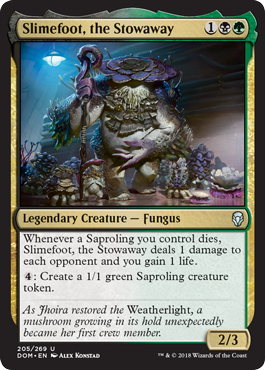
I don't want to give away any of the story, but I can say some names you might know are going to join Jhoira and board the Weatherlight.

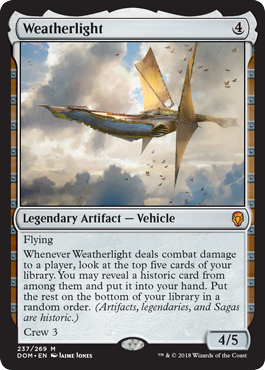
That's all I've got for today. There are many more Dominaria stories to come, but I hope today gives you a sense of how the vision design for the set came together. As always, I'm eager for your feedback, even more so because we're finally talking about Dominaria. You can email me or contact me through any of my social media accounts (Twitter, Tumblr, Google+, and Instagram).
Join me next week for more Dominaria goodness.
Until then, may you have as much fun playing with Dominaria as we did making it.
#523: GDS3 Trial 2, Part 3
#523: GDS3 Trial 2, Part 3
In this podcast, I go over the answers for the final 25 questions in the Trial 2 multiple-choice test for the Great Designer Search 3.
#524: GDS3 Trial 3
#524: GDS3 Trial 3
In this podcast, I go over the design test, the third trial for the Great Designer Search 3.
- Episode 522 GDS3, Trial 2, Part 2
- Episode 521 GDS3, Trial 2, Part 1
- Episode 520 GDS3, Trial 1




